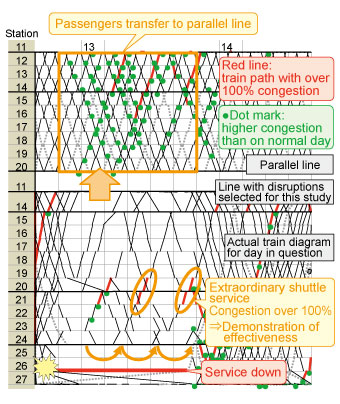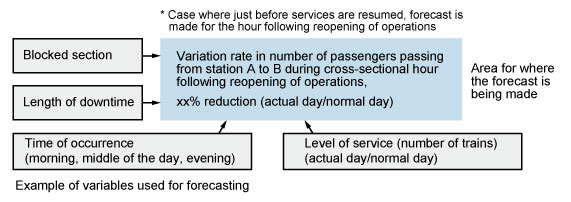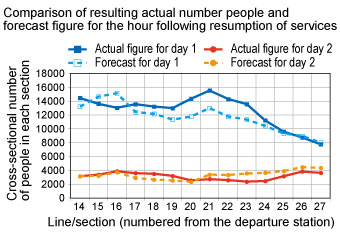4. Using recorded data to analyse passenger flows when traffic is disrupted
- A proposal was made for a method to visualise passenger flows when traffic is disrupted, based on recorded transport data
- A method was then built to quantitatively predict passenger flows before and after resumption of operations
It is important to be able to estimate the volume of passengers in different areas before and after a period of traffic disruption, in order to reschedule traffic in a way which ensures that sufficient transport capacity is provided. As such, a method was developed to forecast and analyse passenger flows during periods when traffic is disrupted, using recorded and collected data about passenger volumes on each train and in each zone as well as actual train arrival and departure times.
The first step was to develop a method whereby an actual train diagram could be visualised against this data (Fig.1). This makes it easy to visualise passenger volumes in each area and train on normal days, and in turn makes it possible to analyse the rescheduled traffic plan through comparison with this ordinary situation.
The next step was to develop a method for forecasting cross sectional numbers of passengers per area or direction (inbound / outbound) around the time when services are expected to resume, based on location of the traffic disruption, time of day and the estimated length of downtime (Fig.2).
This method therefore makes it possible to make appropriate rescheduling plans in advance to ensure that sufficient transportation capacity is provided after services resume following a traffic disruption.
The proposed method was tested for actual commuter lines which have faced multiple disruptions. Results showed that forecasts varied within a margin of around 10%, compared with actual recorded data. This means that this method is sufficiently accurate to be applied in practice to produce rescheduling plans (Fig.3).

Fig.1 Visualisation of actual traffic management and
passenger flow figures (example of metropolitan
line section with parallel running lines)
Fig.2 Model for predicting cross-sectional number of
people around time when services are to resume
Fig.3 Results of prediction model verification tests